List of African dishes
This is a list of notable dishes found in African cuisine. African cuisine is a generalized term collectively referring to the cuisines of Africa. The continent of Africa is the second largest landmass on Earth, and is home to hundreds of different cultural and ethnic groups. This diversity is also reflected in the many local culinary traditions in terms of choice of ingredients, style of preparation and cooking techniques.
African dishes
This is a dynamic list and may never be able to satisfy particular standards for completeness. You can help by expanding it with reliably sourced entries.
| Name | Image | Country/region | Description |
|---|---|---|---|
| Achu | Cameroon | A dish consisting of pounded cocoyams and a red palm oil soup. Served with cow skin, oxtail, tripe, and steamed eggplant. | |
| Afang | Nigeria | A vegetable soup which has it origin from the Efik people in the southeast of Nigeria. | |
| Ahriche | Morocco | Tripe wrapped around sticks and cooked over hot coals. | |
| Akara | 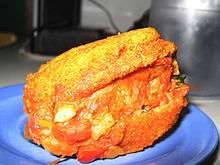 |
Nigeria and Cameroon | Peeled black-eyed peas made into balls and deep-fried. |
| Alloco | 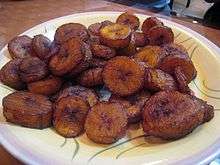 |
Cote d'Ivoire | A fried plantain snack, often served with chili pepper and onions. |
| Amala | 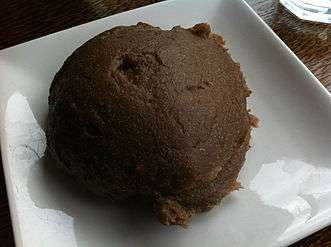 |
Nigeria | Yam porridge, served with a variety of soups. |
| Asida | |
North Africa | A lump of cooked wheat flour dough, sometimes with butter or honey added.[1] |
| Attiéké | |
Côte d'Ivoire | A side or main dish made from cassava that is a part of the cuisine of Côte d'Ivoire in Africa. |
| Baba ghanoush |  |
Levant | Mashed eggplant with virgin olive oil and various seasonings. |
| Babute | Democratic Republic of Congo | Ground beef, curry powder, and apricots. | |
| Banga soup |  |
Nigeria and Cameroon | It is made from palm nuts and is eaten primarily in the southern and midwestern parts of Nigeria. |
| Bar-One Cake | South Africa | This is a popular variant of a chocolate cake in South Africa, using the cocoa wafer "Nestlé Bar One" as the main ingredient. | |
| Bazeen |  |
Libya | Barley dough served with tomato sauce, eggs, potatoes, and mutton. |
| Bichak | Morocco | A stuffed tricornered appetizer. | |
| Biltong, or Kilichi |  |
Southern Africa, Cameroon, Nigeria | Similar to jerky. Raw meat, such as beef or game meats like ostrich, cut into strips, cured and dried. |
| Bobotie | 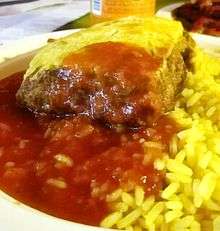 |
South Africa | Spiced ground meat with an egg topping. |
| Boerewors |  |
South Africa | This is a South African spiced mixed-meat sausage that was developed by the Afrikaans-speaking white farmers, the Boere, and is now used nationwide as a symbol of heritage by all races. It contains coarsely minced beef, pork and occasionally lamb. It is traditionally flavored with coriander and black pepper but can have a multitude of spices, like chili pepper. Though each butcher has his own unique recipe, a council has been formed to evaluate exactly what can be labelled as "boerewors". The council has stated that the requirements for labeling it as boerewors is that the sausage must contain 80% or more ground beef, 20% or less pork (including cubes of pork-fat) and the spices coriander and black pepper. |
| Boerewors-roll, or boerie-roll | South Africa | This a popular South African variant of the global hot dog phenomenon. It consists of a braaied boerewors served in a hot dog bun with onion relish and usually ketchup/tomato sauce and mustard. It can also be served with various chili sauces. | |
| Braaibroodtjies | South Africa | This is a popular South African variant of a toasted sandwich, where the sandwich is grilled (braaied) over an open charcoal or wood flame instead of in an electric sandwich toaster. The name translates directly as "grilled-sandwich." | |
| Brik | 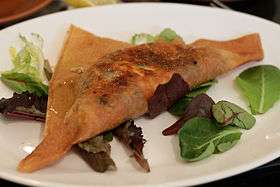 |
Tunisia | Stuffed pastry. |
| Briouat |  |
Morocco | Sweet puff pastry. |
| Bunny chow | 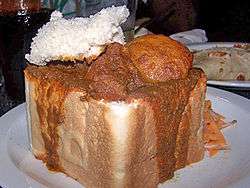 |
South Africa | Often simply called "Bunny", a fast food dish that is a hollowed out loaf of bread filled with curry. |
| Cachupa |  |
Cape Verde | A stew of hominy, beans, and meat. |
| Chakalaka |  |
South Africa | Vegetable relish. |
| Chakchouka | |
Tunisia | A stew of lamb, spices, tomatoes, and flatbread. |
| Chermoula | 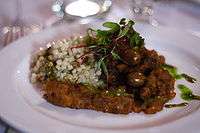 |
North Africa | A marinade of oil, lemon juice, pickled lemons, herbs, garlic, cumin, and salt, most often used to flavor seafood. |
| Cocada amarela | Angola | A dessert of eggs and coconut. | |
| Couscous |  |
North Africa | A semolina pasta. |
| Delele | Zimbabwe | Okra prepared with baking soda. | |
| Draw soup | Nigeria | A soup of okra or pumpkin seeds. | |
| Droëwors | 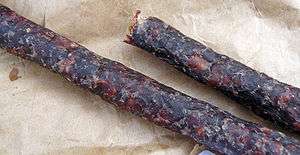 |
South Africa | This is a boerewors that has been dried and cured in a similar way to biltong. The name translates literally as "dried sausage". |
| Duqqa |  |
Egypt | A dip of herbs and spices. |
| Echicha |  |
Nigeria | Cassava, pigeon pea, and palm oil. |
| Ekwang | Cameroon | A dish of grated cocoyams wrapped in cocoyam leaves and cooked in a spicy stew. | |
| Eru | Cameroon | A stew made with finely sliced Gnetum africanum (eru) leaves cokked with waterleaf and red palm oil. Usually eaten with waterfufu, a type of fufu made from fermented cassava. | |
| Feijoada |  |
Southern Africa | A stew of beans, beef, and pork. |
| Fesikh | |
Egypt | Fermented, salted mullet. |
| Fig roll | 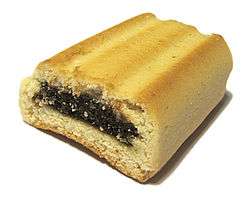 |
Egypt | An ancient Egyptian pastry, filled with fig paste. |
| Fit-fit | 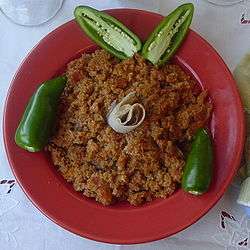 |
Ethiopia and Eritrea | An Eritrean and Ethiopian food typically served for breakfast (though it can be served with other meals). |
| Freekeh |  |
Levant | A cereal food made from green wheat that goes through a roasting process in its production. It is an Arab dish that is especially popular in Levantine, Arabian Peninsula, Palestinian and Egyptian cuisine, but also in North African and other neighboring cuisines.[1][2] |
| Frejon | Nigeria | Frejon (from Feijão, the Portuguese word for "beans") is a coconut bean soup which is eaten especially during Holy Week by a selection of Christians, mostly Catholics, across the world. | |
| Frikkadel | Southern Africa | A traditional Afrikaner dish comprising usually baked, but sometimes deep-fried, meatballs prepared with onion, bread, eggs, vinegar and spices. | |
| Fufu | 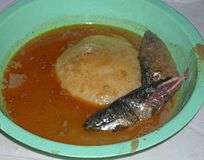 |
Ghana, Cameroon, Nigeria | Boiled starchy vegetables like cassava, yams or plantains which are pounded into a dough-like consistency and eaten in small balls, served with a dipping soup or sauce. |
| Ful medames |  |
Egypt | Mashed fava beans with olive oil, chopped parsley, onion, garlic, and lemon juice. |
| Funkaso | Nigeria | A Nigerian dish of millet pancakes containing millet, butter and sugar. | |
| Ga'at | 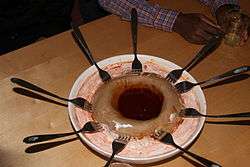 |
Ethiopia and Eritrea | A stiff porridge, made traditionally with barley flour,[3] though in many communities wheat flour is often used. |
| Garri | .jpg) |
Nigeria, Cameroon | A popular West African food made from cassava tubers. |
| Gatsby |  |
South Africa | A South African style of deli sandwich very similar in content and method of preparation as a hoagie in the United States. It is mostly popular in the Western Cape province. |
| Gored gored | Ethiopia and Eritrea | A raw beef dish that is typically cubed and left unmarinated. | |
| Harira |  |
Algeria and Morocco | A traditional Algerian and Moroccan soup of Maghreb. |
| Hawawshi | Egypt | A traditional Egyptian food very similar to the Middle eastern pizza-like Lahmacun. It is meat minced and spiced with onions and pepper, parsley and sometimes hot peppers and chilies, placed between two circular layers of dough, then baked in the oven. | |
| Hertzoggie |  |
South Africa | Minijam and coconut tarts, usually filled with apricot-jam, that were named in honor of the South African Prime Minister (1929-1934), Gen. J.B.M. Hertzog, who noted that these tarts are his favourite tea-time treat. They play a significant part in the History of South Africa and are still very popular among Afrikaners. |
| Himbasha |  |
Ethiopia and Eritrea | An Ethiopian and Eritrean celebration bread, which is slightly sweet.[4] |
| Injera |  |
Ethiopia and Eritrea | A yeast-risen flatbread with a unique, slightly spongy texture. Traditionally made out of teff flour,[5] it's a national dish in Ethiopia and Eritrea. A similar variant is eaten in Somalia (where it is called canjeelo or lahooh) and Yemen (where it is known as lahoh). |
| Iru | |
Nigeria | A type of fermented locust beans used as a condiment in cooking, similar to ogiri and douchi, and is very popular among the Yoruba people of Nigeria. It is used in cooking traditional soups like egusi soup, okro soup and ogbono soup. |
| Isi ewu | .jpg) |
Nigeria | A traditional Eastern Nigeria dish that is made with a goat's head.[6] |
| Isidudu | Southern Africa | A pap dish made to simmer with pumpkin, curried cabbage and liver. | |
| Jaffle | South Africa | This is a popular variant of a toasted sandwich. This variant specifically refers to any sandwich with a meat-based filling (usually minced beef), that is toasted in a "jaffle iron" over an open flame or in an electrical toaster. | |
| Jollof rice |  |
Nigeria and Senegal | Also called "benachin", meaning "one pot" in the Wolof language of Senegal, this is a popular dish in many parts of West Africa.[7] It is thought to have originated in Gambia but has since spread to the whole of West Africa, especially Côte d'Ivoire, Ghana Mali, and Nigeria, among members of the Wolof ethnic group.[8][9] |
| Kachumbari | 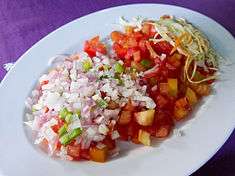 |
East Africa | A fresh tomato and onion salad. |
| Kebab |  |
Middle East | A wide variety of grilled or barbecued meat dishes often skewered (Shish Kebabs) originating in the Middle East and later on adopted in Turkey, Azerbaijan, Southern Europe, South Asia and Asia Minor, now found worldwide. |
| Kedjenou | 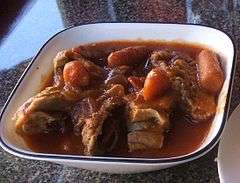 |
Côte d'Ivoire | A spicy stew that is slow-cooked in a sealed canari (terra-cotta pot) over fire or coals and prepared with chicken or guinea hen and vegetables |
| Kelewele |  |
Ghana and Liberia | Fried plantains seasoned with spices. |
| Kenkey |  |
Ghana | A staple dish similar to a sourdough dumpling from the Akan, Ga and Ewe inhabited regions of West Africa, usually served with a soup, stew, or sauce. |
| Kitcha |  |
Ethiopia and Eritrea | A basic, thin, unleavened bread, cooked until slightly burned. |
| Kitfo | 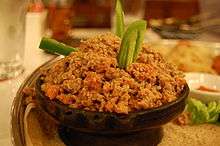 |
Ethiopia and Eritrea | Raw beef marinated in mitmita (a chili powder based spice blend) and niter kibbeh. |
| Koeksister | |
South Africa, Namibia and Botswana | A South African syrup-coated doughnut in a twisted or braided shape (like a plait). |
| Koki | Cameroon | A dish of steamed black eyed peas with red palm oil and hot peppers. | |
| Konkonte |  |
Ghana | A famine food of Ghana made from dried and pounded manioc root. |
| Kuli-kuli |  |
Nigeria, Cameroon | A Hausa food that is primarily made from peanuts. It is a popular snack in Nigeria. |
| Kushari |  |
Egypt | Made from rice, lentils, chickpeas and macaroni covered with tomato sauce and fried onions. |
| Lablabi | 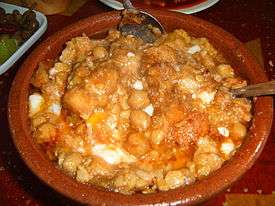 |
Tunisia | A Tunisian dish based on chick peas in a thin garlic and cumin-flavoured soup, served over small pieces of stale crusty bread. |
| Lahoh |  |
Somalia | A spongy, pancake-like bread originating in Djibouti, Somalia and Yemen.[10][11] It is also popular in Israel, where it was introduced by Yemenite Jews who immigrated there.[12] |
| Lamington | 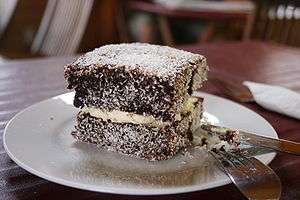 |
Australia and South Africa | A sponge cake that has been dipped in chocolate-syrup and desiccated coconut. Originally from Australia, the dessert became very popular among Afrikaners and is commonly referred to in South Africa by their Afrikaans name "ystervarkies", which is an Afrikaans word for a porcupine, which the dessert resembles. |
| Maafe | |
Mali | A stew or sauce (depending on water content) common to much of West Africa.[7] It originates from the Mandinka and Bambara people of Mali.[13] Variants of the dish appear in the cuisine of nations throughout West Africa and Central Africa. |
| Makroudh | |
Tunisia and Morocco | A pastry often filled with dates or almonds. |
| Mala Mogodu | Southern Africa | A South African food, Mogodu is a derivative of tripe served as a stew with hot pap usually in winter. | |
| Malva pudding |  |
Southern Africa | A sweet pudding of Afrikaner origin, usually served hot with custard or ice-cream. It is made with apricot jam and has a spongy caramelized texture. It is often found on the dessert menu of South African restaurants. |
| Mandazi | 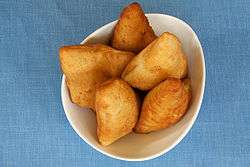 |
East Africa | A fluffy fried bread snack, Mandazi is a form of fried bread that originated in Eastern Africa in the Swahili coastal areas of Kenya and Tanzania.[14] It is still popular in the region, as it is convenient to make, can be eaten with almost any food or dips or just as a snack by itself, and can be saved and reheated for later consumption.[15][16] |
| Matbucha | |
Morocco | Tomatoes and roasted bell peppers cooked together, seasoned with garlic and chili pepper.[17] The name of the dish originates from Arabic and means "cooked [salad]". It is served as an appetizer, often as part of a meze. In Israel it is sometimes referred to as "Turkish salad" (Hebrew: סלט טורקי salat turki).[18] |
| Matoke | 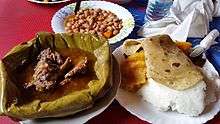 |
Uganda | A meal consisting of steamed green banana (or plantain) and is one of the national dishes of Uganda. |
| Mbongo Tchobi | Cameroon | A black soup made from the burnt mbongo spice, usually cooked with meat or fish and served with steamed ripe plantains. | |
| Méchoui |  |
North Africa, Cameroon | A whole sheep or a lamb spit roasted on a barbecue. It is popular in North Africa and among the Bamileke people of Cameroon. |
| Melktert |  |
South Africa, Namibia and Botswana | A South African dessert. It is a sweet pastry crust containing a creamy filling made from milk, flour, sugar and eggs. |
| Merguez | 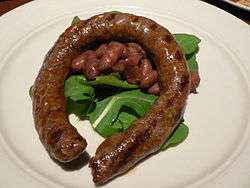 |
North Africa | A very spicy, red sausage of mutton or beef. |
| Mesfouf | 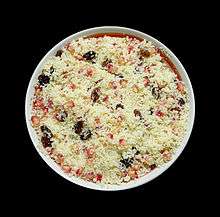 |
Tunisia | Similar to couscous, with butter added. |
| Moin moin | 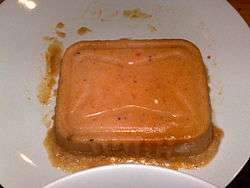 |
Nigeria | A Nigerian steamed bean pudding made from a mixture of washed and peeled black-eyed beans, onions and fresh ground peppers (usually a combination of bell peppers and chilli or scotch bonnet). |
| Mrouzia |  |
Morocco | Sweet and salty tajine with honey, cinnamon and almonds. |
| Msemen | .jpg) |
Maghreb | Traditional pancakes in Maghreb. These pancakes are usually used as an accompaniment to a cup of aromatic morning mint tea or of creamy coffee. Msemen can also be stuffed with vegetables or meat fillings. |
| Mugoyo | Uganda | Mugoyo is a traditional main course dish in Uganda. The main ingredients of the dish are sweet potatoes and beans.The purple sweet potatoes are steamed in banana leaves while the red kidney beans are boiled with some seasoning. They are then mingled together to form one dish. | |
| Mukhbaza | Eritrea | Wheat flour bread with ghee, banana, honey, and other ingredients. | |
| Mulukhiyah | |
Egypt | The leaves of the Corchorus species are used as a vegetable in Middle Eastern, East African, North African, and South Asian cuisine. Mulukhiyyah is rather bitter, and when boiled, the resulting liquid is a thick, highly mucilaginous broth; it is often described as "slimy," rather like cooked okra. |
| Nando's famous flame-grilled Peri Peri Chicken |  |
South Africa | Nando's is a South African chain restaurant that specializes in spicy chicken dishes, most notably the Peri Peri Chicken. The dish uses the Piri Piri spice (also spelled "Peri Peri"). |
| Ndolé | |
Cameroon | A national dish of Cameroon.[19] The dish consists of a stew of nuts, ndoleh (bitter leaves indigenous to West Africa), and fish or ground beef.[19] |
| Nshima | |
Central Africa | A cornmeal product and a staple food in Zambia, Malawi and the Kasai Oriental and Kasai Occidental provinces of the Democratic Republic of Congo. It is made from ground maize (corn) flour known locally as "mealie-meal". Nshima is very similar to ugali or posho of East Africa, sadza of Zimbabwe, pap of South Africa and fufu of West Africa. |
| Obusuma |  |
Kenya | A Kenyan dish made from maize flour (cornmeal) cooked with boiling water to a thick porridge dough-like consistency. In Luhya cuisine it is the most common staple starch. |
| Ogbono soup | Nigeria | A Nigerian dish made with ground ogbono seeds,[20] with considerable local variation. The ground ogbono seeds are used as a thickener, and give the soup a black coloration. Besides seeds, water and palm oil, it typically contains meat, seasonings such as chili pepper,[20] leaf vegetables and other vegetables. | |
| Ogi | Nigeria | Fermented cereal pudding from Nigeria, typically made from maize, sorghum, or millet.[21] | |
| Owofibo | Nigeria | An oil soup made of blended tomato mixed with akun and palm oil. | |
| Pakora | .jpg) |
South Asia | A fried snack (fritter) found across South Asia.[22] Pakora is made by taking one or two ingredients such as onion, eggplant, potato, spinach, plantain, paneer, cauliflower, tomato, chili pepper, or occasionally bread[23] or chicken, dipping them in a batter of gram flour and then deep-frying them. |
| Pampoenkoekies | South Africa | Also known by its English name "pumpkin fritters", they are pumpkin-based (usually butternut squash) balls of dough that is mixed with baking flour and eggs which are then fried in a pan and sprinkled with cinnamon and sugar. They are a popular snack for Afrikaners and can usually be served at a braai (social gathering among Afrikaners). | |
| Pap | 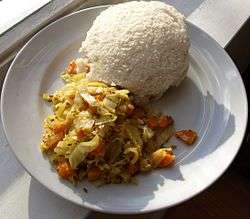 |
Southern Africa | A traditional porridge of mielie-meal (ground maize) or other grain. |
| Pap en Vleis | South Africa | This is a popular South African dish, of Afrikaner origin, which usually consists of a crumbly phutu pap and a tomato-based meat sauce, usually served with boerewors. The boerewors can be braaied separately, or it can be cooked in the sauce. If time permits it, the pap can be replaced with samp. The name translates as "porridge and meat". | |
| Pastilla | 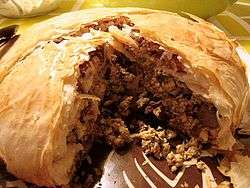 |
Algeria and Morocco | A traditional Moroccan dish, an elaborate meat pie traditionally made of squab (fledgling pigeons). As squabs are often hard to get, shredded chicken is more often used today; pastilla can also use fish or offal as a filling. |
| Phutu | 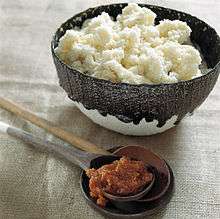 |
South Africa | A traditional maize meal dish from South Africa. It is a crumbly or grainy type of pap (polenta) or porridge, eaten mainly by the Basotho, Bantu and Afrikaner people. It is cooked in cauldrons or potjies over an open fire, stirred with great care until a course consistency in texture is reached. |
| Placali | Ivory Coast | Placali is a fermented cassava paste usually eaten with palm kernel sauce, okra or Kpala. The origin of this dish is unknown and this dish is appreciated as in all regions of Ivory Coast. | |
| Potbrood | 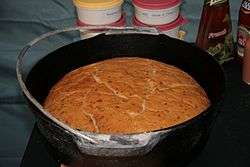 |
South Africa, Namibia and Botswana | A bread first made by the Boer settlers of what is now South Africa. Potbrood was traditionally baked in a cast iron pot (also known as a Dutch oven) in a pit made in the ground and lined with hot coals.[24] Today potbrood is often made at a braai by packing charcoal or wood coals around a cooking pot.[25] |
| Potjiekos |  |
Namibia and South Africa | Literally translated "small pot food", is a stew prepared outdoors. It is traditionally cooked in a round, cast iron, three-legged pot, the potjie, brought from the Netherlands to South Africa in the 17th century and found in the homes and villages of people throughout southern Africa.[26] |
| Qatayef | 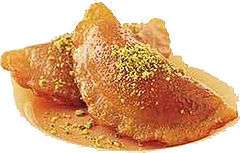 |
Egypt | An Arab dessert commonly served during the month of Ramadan, a sort of sweet dumpling filled with cream or nuts. It is usually prepared using Akkawi cheese as a filling.[27][28] |
| Sadza | |
Zimbabwe Southern Africa and Eastern Africa | Sadza in Shona (isitshwala in isiNdebele, pap in South Africa, or nsima in the Chichewa language of Malawi), Ugali in East Africa, is a cooked cornmeal that is the staple food in Zimbabwe and other parts of southern and eastern Africa. This food is cooked widely in other countries of the region. |
| Samosa |  |
Widespread | Fried or baked pastry with a savory filling such as spiced potatoes, onions, peas, lentils, ground lamb or chicken. |
| Seswaa |  |
Botswana | A traditional meat dish of Botswana, made of beef, goat or lamb meat.[29] The fatty meat is generally boiled until tender in any pot, with "just enough salt",[30] and shredded or pounded.[31] It is often served with pap (maize meal) or sorghum meal porridge.[32][33] |
| Sfenj |  |
North Africa | Donuts cooked in oil then soaked in honey or sprinkled with sugar. |
| Shahan ful |  |
North Africa | A common dish in Eritrea, Ethiopia, Sudan and the region, and is generally served for breakfast. Believed to be an import from Sudan, it is made by slowly cooking fava beans in water that are then crushed into a paste, which is then served alongside a diverse variety of foods. It is typically eaten without the aid of utensils accompanied with a bread roll. It is popular during the Ramadan season and Lent. |
| Shakshouka |  |
Northwest Africa | A dish of eggs poached in a sauce of tomatoes, chili peppers, and onions, often spiced with cumin.[34] It is believed to have a Tunisian origin.[35] |
| Shiro |  |
Ethiopia and Eritrea | A homogenous stew whose primary ingredient is powdered chickpeas or broad bean meal. It is often prepared with the addition of minced onions, garlic and depending upon regional variation; ground ginger or chopped tomatoes and chili-peppers. Shiro is usually served atop injera, however, it can be cooked in shredded taita and eaten with a spoon, this version would be called shiro fit-fit. |
| Shish taouk | 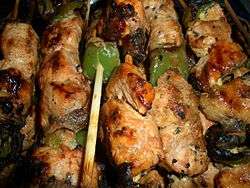 |
North Africa | Marinated cubes of chicken are skewered and grilled. |
| Skilpadjies | South Africa | A traditional South African food, also known by other names such as "muise", "vlermuise" and "pofadder". The dish is lamb's liver wrapped in netvet (caul fat), which is the fatty membrane that surrounds the kidneys. Most cooks mince the liver, add coriander, chopped onion, salt and Worcestershire sauce then wrap balls of this mixture with the netvet and secure it with a toothpick. The balls, approximately 80mm in diameter, are normally grilled over an open charcoal fire and ready when the fat is crisp. | |
| Sosatie |  |
Botswana, Namibia and South Africa | A traditional South African dish of meat (usually lamb or mutton) cooked on skewers. The term derives from "sate" ("skewered meat") and "saus" ("spicy sauce"). It is of Cape Malay origin, used in Afrikaans, the primary language of the Cape Malays, and the word has gained greater circulation in South Africa. |
| Suya | |
Nigeria, Niger, Cameroon | A shish kebab like food popular in West Africa, originally from the Hausa people of northern Nigeria, northern Cameroon and Niger. Suya is generally made with skewered beef, goat meat, fish, or chicken. The meat is rubbed-in with tankora, a dry spice mix containing powdered groundnuts, cayenne pepper, ginger, paprika and onion powder, then barbecued. |
| Tabil | Tunisia | A Tunisian spice mixture consisting of ground coriander seed, caraway seed, garlic powder, and chili powder. The term can also refer to coriander by itself.[36] | |
| Tahini |  |
North Africa | A paste made from ground, hulled sesame seeds used in North African, Greek, Turkish and Middle Eastern cuisine. Tahini is made from sesame seeds that are soaked in water and then crushed to separate the bran from the kernels. The crushed seeds are soaked in salt water, causing the bran to sink. The floating kernels are skimmed off the surface, toasted, and ground to produce an oily paste.[37] |
| Tajine |  |
North Africa | A Maghrebi dish from North Africa, that is named after the special earthenware pot in which it is cooked. A similar dish, known as tavvas, is found in the cuisine of Cyprus. The traditional tajine pot is formed entirely of a heavy clay, which is sometimes painted or glazed. Tajines in Moroccan cuisine are slow-cooked stews braised at low temperatures, resulting in tender meat with aromatic vegetables and sauce. |
| Tapalapa bread | West Africa | A traditional bread of western Africa, mainly in Senegal, The Gambia and Guinea. | |
| Tapioca pudding | 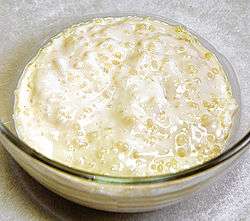 |
Widespread | A sweet pudding made with tapioca and either milk or cream. Coconut milk is also used in cases in which the flavor is preferred or in areas in which it is a commonplace ingredient for cooking. It is made in many cultures with equally varying styles, and may be produced in a variety of ways.[38] Its consistency ranges from thin (runny), to thick, to firm enough to eat with a fork. |
| Thieboudienne | |
Senegal | Made with fish, rice and tomato sauce, and may also include onions, carrots, cabbage, cassava and peanut oil. |
| Tomato bredie | .jpg) |
Namibia and South Africa | A South African stew, referred to in Afrikaans as "tamatiebredie", normally made with mutton, is cooked for a very long time, and its seasonings include cinnamon, cardamom, ginger and cloves as well as chilli. It is of Dutch origin. |
| Torta de Gazpacho | |
Algeria | A type of torta, or flat bread. |
| Toum |  |
Levant | A garlic sauce as prepared in Lebanon, the Levant, and Egypt similar to the European aioli. It contains garlic, salt, olive oil or vegetable oil, and lemon juice crushed using a wooden mortar and pestle.[39] There is a variation popular in many villages, such as Zgharta, where mint is added, called "Zeit and Toum".[40] |
| Ugali |  |
African Great Lakes | A dish of maize flour (cornmeal) cooked with water to a mush,[7] porridge- or dough-like consistency. It is the most common staple starch featured in the local cuisines of the eastern African Great Lakes region and Southern Africa. When ugali is made from another starch, it is usually given a specific regional name. See also pap. |
| Umngqusho | 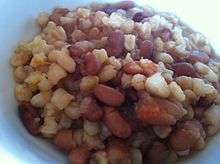 |
Widespread | A Bantu dish with several variants. |
| Usban | |
Libya and Tunisia | A traditional kind of Tunisian sausage, stuffed with a mixture of rice, herbs, lamb, chopped liver and heart.[41][42] This dish is usually served alongside the main meal of rice or couscous, often on special occasions. |
| Vetkoek | 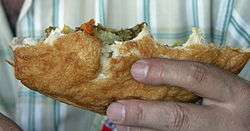 |
Southern Africa | Dough deep-fried in cooking oil and either filled with cooked mince (ground beef) or spread with syrup, honey, or jam. |
| Wat | 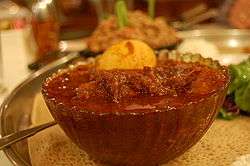 |
Ethiopia and Eritrea | An Ethiopian and Eritrean stew or curry that may be prepared with chicken, beef, lamb, a variety of vegetables, spice mixtures such as berbere, and niter kibbeh, a seasoned clarified butter. Wats are traditionally eaten with injera, a spongy flat bread made from the millet-like grain known as teff. |
| Waterblommetjiebredie | |
South Africa | A stew made of meat, typically lamb, stewed together with the waterblommetjies (Aponogeton distachyos flowers, commonly known as Cape pondweed, Cape hawthorn or Cape asparagus) which are found in the dams and marshes of the Western Cape of South Africa. |
| Yassa | |
Senegal | A spicy, marinated fish or poultry dish prepared with onions and lemon. Its ingredients may also include peanut or olive oil, parsley, bay leaves, green seedless olives, black pepper, green or red bell peppers, or mustard. |
Unsorted
See also
References
- 1 2 "Did You Know: Food History - Famous Everyday Dishes from the Medieval Arab World". cliffordawright.com. Retrieved 3 July 2015.
- ↑ Anissa Helou, "Freekeh", in Alan Davidson (editor), The Oxford Companion to Food
- ↑ "Eritrean Community" (PDF). Seniorscouncil.net. Retrieved 2016-06-30.
- ↑ Warren, Olivia (2000). Taste of Eritrea: Recipes from One of East Africa's Most Interesting Little Countries. Hippocrene Books, Inc. ISBN 978-0-7818-0764-7.
- ↑ "Ethiopian Injera Recipe - Exploratorium". Exploratorium: the museum of science, art and human perception. Retrieved 3 July 2015.
- ↑ Edet, Laura. "Nigeria Recipes: ISI-EWU (spiced goat head)". Retrieved 20 May 2009.
- 1 2 3 "List of African Foods". USA Today. March 10, 2010. Retrieved September 6, 2016.
- ↑ Ellen Gibson Wilson (2008-09-10). A West African cook book. Books.google.co.uk. Retrieved 2016-06-30.
- ↑ "Jollof Rice Recipe (West African chicken with rice)". Whats4eats.com. Retrieved 2016-06-30.
- ↑ "Little Business Women". yobserver.com. Retrieved 3 July 2015.
- ↑ Mohamed Diriye Abdullahi, Culture and Customs of Somalia, (Greenwood Press: 2001), p. 113.
- ↑ "Cafe Liz - Hatikva market — the other side of Tel Aviv - the kosher vegetarian Israeli food blog". Cafe Liz. Retrieved 3 July 2015.
- ↑ James McCann. Stirring the pot: a history of African cuisine, p132. Ohio University Press, 2009; ISBN 0-89680-272-8
- ↑ "Mandazi - The Congo Cookbook". The Congo Cookbook. Retrieved 13 November 2009.
- ↑ Peck, Richard. "Swahili Recipes". Lewis & Clark. Retrieved 2009-11-13.
- ↑ "Kenyan Cookbook". Expanding Opportunities. Retrieved 2009-11-13.
- ↑ "Archived copy". Archived from the original on October 13, 2012. Retrieved November 17, 2012.
- ↑ A Taste of Challah: A Comprehensive Guide to Challah and Bread Baking, Tamar Ansh, Feldheim Publishers, 2007, p. 150
- 1 2 Brady, Emily (2008-11-05). "The Years of Living Nervously". New York Times. Retrieved 2008-12-07.
- 1 2 Wright, Clifford A. (2011). The Best Soups in the World. John Wiley & Sons. p. 51. ISBN 1118109252.
- ↑ "Fermented Cereals - A Global Perspective". United Nations FAO. Retrieved 22 July 2006.
- ↑ Devi, Yamuna (1999). Lord Krishna's Cuisine: The Art of Indian Vegetarian cooking. New York: E. P. Dutton. pp. 447–66. ISBN 0-525-24564-2.
- ↑ Arora, Ritu (2002). Healthy Kitchen: More Than 350 Oil Free Recipes. New Delhi, India: B. Jain publishers (P) Ltd. pp. 186, Bread Pakora. ISBN 81-8056-208-5.
- ↑ "South African Bread Recipes". South-african-homeschool-curriculum.com. 2013-10-17. Retrieved 2016-06-30.
- ↑ Baker, Donald. "Potbrood/Pot Bread in South African Cuisine". Ejozi.co.za. Retrieved 2016-06-30.
- ↑ Stan Engelbrecht; Tamsen de Beer; Ree Treweek (2005). African salad: A portrait of South Africans at Home. Day One Publishing. ISBN 0-620-35451-8.
- ↑ A Woman of Egypt. Books.google.com. Retrieved 3 July 2015.
- ↑ The Pure and Powerful. Books.google.com. Retrieved July 3, 2015.
- ↑ Matthew D. Firestone; Adam Karlin. Botswana & Namibia. Books.google.com. p. 70. Retrieved 2016-06-30.
- ↑ Culture and Customs of Botswana. Books.google.com. Retrieved July 3, 2015.
- ↑ "Food, Cuisine, and Cultural Competency for Culinary, Hospitality, and ...". google.com. Retrieved July 3, 2015.
- ↑ Botswana - Culture Smart!. Books.google.com. Retrieved 3 July 2015.
- ↑ Tourism Destinations Southern Africa. Books.google.com. Retrieved 3 July 2015.
- ↑ Claudia Roden, The new book of Middle Eastern food, p. 168
- ↑ International Inner Wheel Sfax, Nos recettes de tous les jours et jours de fêtes, p. 115
- ↑ Marks, Gil (2010). Encyclopedia of Jewish Food. John Wiley and Sons. p. 572. ISBN 0-470-39130-8.
- ↑ "What is tahini?". ochef.com. Retrieved July 3, 2015.
- ↑ "Mango & Tapioca Pearls Dessert". christinesrecipes.com. 27 January 2010. Retrieved 6 September 2012.
- ↑ "Toum". Allrecipes.com. Retrieved July 3, 2015.
- ↑ Fayed, Saad. "Toum Lebanese Dipping Sauce - Recipe". About.com Food. Retrieved July 3, 2015.
- ↑ Marks, Gil (2010). Encyclopedia of Jewish Food. Hoboken, New Jersey: John Wiley & Sons. p. 1. ISBN 978-0-470-39130-3. Retrieved February 9, 2012.
- ↑ Clifford A. Wright (1999). A Mediterranean Feast. New York, New York: William Morrow & Co. pp. 72–73. ISBN 0-688-15305-4. Retrieved February 9, 2012.
Further reading
- McCann, James C. (2009). Stirring the Pot: A History of African Cuisine. Athens, Ohio: Ohio University Press. ISBN 9780896802728. Retrieved November 1, 2016.
This article is issued from Wikipedia - version of the 12/1/2016. The text is available under the Creative Commons Attribution/Share Alike but additional terms may apply for the media files.